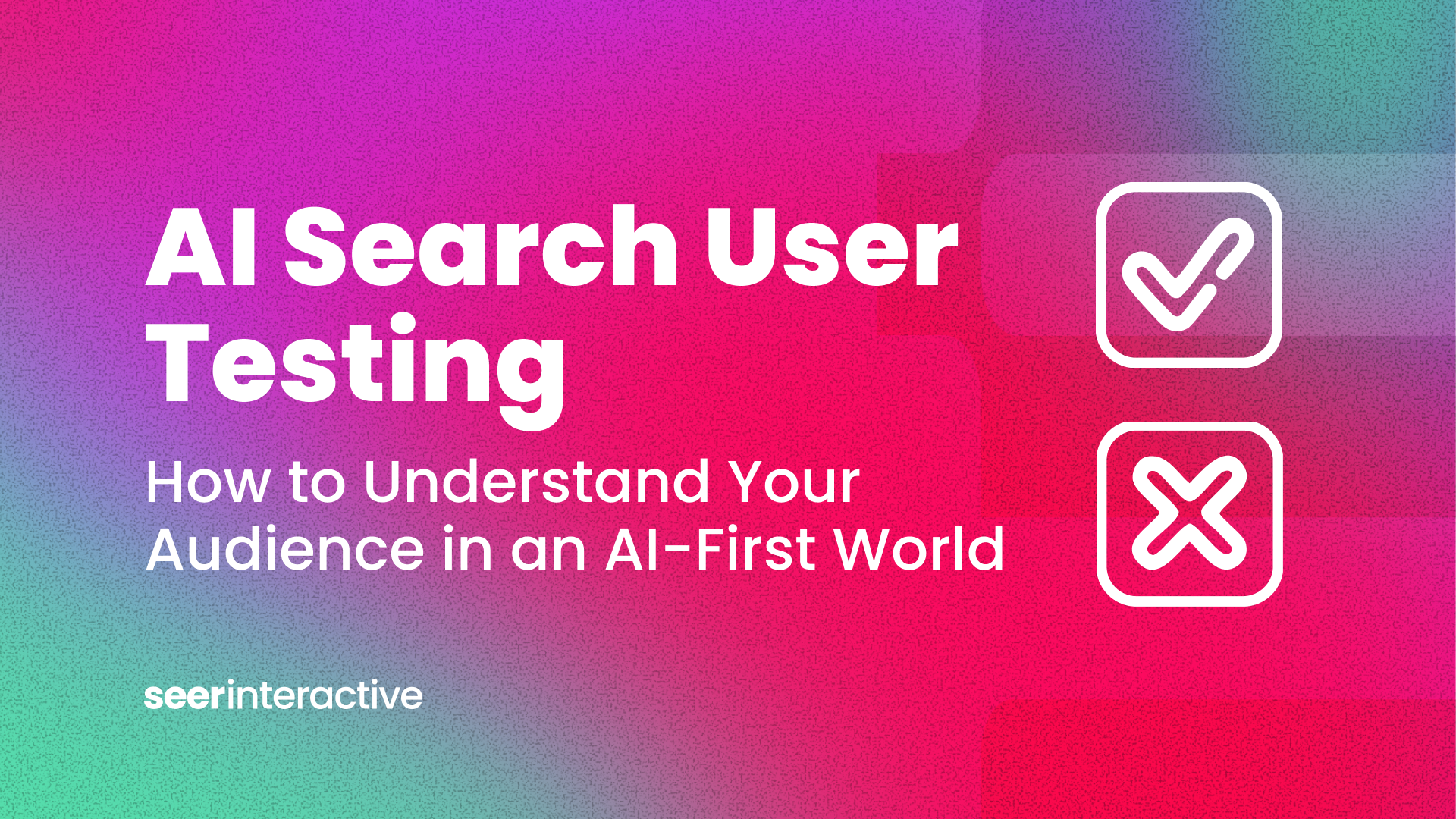It’s Just Modern SEO, or is it?
At Seer, we have always been in the “helping people get answers" business.
Generative AI search has promised to change the way people find answers to their questions, with a lot less friction. For now, not having cluttered layouts, and typing in your natural language are some of the biggest pros of searching for answers in Generative AI vs traditional searching in Google.

The brief history of Generative AI Search Engines
People are "searching" Claude, Llama, ChatGPT, Perplexity, Gemini and more.
| ChatGPT (Training based) | November, 2022 |
| Perplexity (AI search engine) | December, 2022 |
| Llama (Training based) | February, 2023 |
| Claude (Training based) | March, 2023 |
| Google Bard > Google Gemini (Hybrid Search + AI) | March, 2023 |
| SearchGPT Beta (AI search engine) | July, 2024 |
| ChatGPT + SearchGPT official launch (Hybrid Search + AI) | December, 2024 |
It is not "just like" SEO!
Your searchers are getting answers in multiple places.
Optimizing for certain types of Generative Engines will feel more like SEO but others will not and dare we say, doing traditional SEO will not help you in certain Generative AI search engines at all.
Your customers are typing in questions and getting answers in the following places where AI is having an impact on what they see.
Search Engines - Google Search (with AI overviews)
Training based AI engines - Claude and Llama rely on training data
Deeply integrated Search AI - Perplexity and ChatGPT+Search (SearchGPT)
Hybrid systems - ChatGPT and Gemini which are making decisions in real time about which approach is right, should it answer based on training data, or answer based on its web index.
Requests for "GEO" are showing up in SEO RFPs (here’s some great pointers for making sure your SEO RFP is asking the right questions), but we’re not defining what we are optimizing for Generative Engine Optimization for training data based engines is very different than it is for hybrids, than more traditional search.
Understanding how AI systems process and present information is crucial. Certain queries give answers in training data, meaning you have to do long term brand building work, some answers run searches to augment the results with fresher perspectives, which is more like traditional SEO.
How will I know which type of queries trigger which type of AI response, training data vs search data? The answer is...
An SEO program looking to bridge to the future of GEO should look at keywords that are likely to have years in them or lots of recent publish dates to make assumptions about content likely to pull from the web index.
Use your SEO reporting to extract how often dates show up in SERPs

Use your Paid Search Reporting to see how often your customers add 2024 or 2025 to their queries.

What exactly is GEO?
Generative Engine Optimization is the practice of optimizing an entity to be featured in the responses generated by AI applications, features, and models like ChatGPT, Gemini, Google’s AI Overviews, Claude, and Perplexity.
My colleague Jordan Strauss wrote an excellent article earlier this year that breaks down early research around GEO. I recommend you check that out for a deeper dive into “how” to do GEO.
Jason Stinnett also talked about optimization vs influencing. In the SEO days you could kind of "growth hack" your way to success, but when AI uses training data for an answer, you got a lot more work to do, so it is more of an influence campaign than an optimization effort.
How is GEO different from SEO? How are they similar?
In SEO, our primary goal is to optimize a website and surface the right content to people searching for solutions in search engines. Yes, there's more to it than that, but at the end of the day, we're driving people directly to our website from Search.
You Influence AI, you Optimize for search engines.
GEO is broader than “website optimization.” The goal is (quite literally) to make something a part of the conversation. Conversational search and traditional search are familiar, but different. The inputs are similar, but the output of generative AI is less structured and varies more than a traditional SERP.
Search engines parse content and match it to people’s queries, then serve it up as a kind of dealer’s choice of where to go next.
LLMs ingest content to learn, and use their understanding of entities to generate responses and recommendations; but they don’t directly return the content they were trained on.
Sure, they may cite a source in a response, but they’re not going to spit back a blog post verbatim, many answers are a remix of the data they have available. What they are trained on impacts the answer remixing, and honestly there's very little data on what they trained on.
Back when most Generative AI's used the common crawl which is open source you could run analyses like this one on this page on the Washington Post, which is still available, but today these LLMs are training on data much greater than the common crawl.

In this world, our carefully produced content serves a different purpose: to educate the LLM and get into its training data to be available for "remixes".
The goal is to position any entity associated with a person’s question as relevant enough to be featured in a gen AI response.
What does success look like SEO metrics vs GEO metrics
SEO success metrics include things like: Rankings, Traffic from Google, CTR’s, monthly search volumes, and conversions.
Here is why each of those SEO metrics doesn’t work in a GEO world, lets go over them one by one.
SEO vs GEO Metrics:
Rankings vs Visibility
So there are no steady rankings, you can search for a phrase today and 5 minutes later get a few different answers for the same query. This is why it is critical to run queries multiple times to see how much brand variance there is. Generative engines have “temperature” settings and temperature settings give it the latitude to get more or less creative.
Let us show you how: Track Your Brand Visibility in a Google Sheet
CTRs & MSVs Are Gone:
Determine opportunity size
Not like we needed more acronyms in this post, but before when clients asked us how much should I invest in SEO, you did the math…
Searches per month x rank x Expected Click Through Rate (CTR) x some conversion rate.
Today that math just doesn’t work in Generative engines.

A holistic search marketer should also be thinking about the impact to paid search, we've seen impact on CTRs when AI overviews show up on Google as well.
Think of all the data you do not have
Rankings tell you if you are visible in Search Engines
SEO: Rankings are attained in webmaster tools or Rank Trackers like Semrush, Ahrefs
GEO: The answers change every 5 minutes, there's no "rankings" you should look for visibility but the tooling is new.
Visible for what? Right, SEO's need keyword lists
SEO: Keywords are attained in webmaster tools and competitive Rank Tracking tools, like Semrush, Ahrefs, etc.
GEO: Get ready for a world where query volume is 1, everyone customizes the query so much that answers will feel unique, prompts with memory could alter queries.

We're crossing fingers for perplexity to give us the questions people are asking about our brands, this is from their ad pitch deck.

How much traffic can I get?
Our traffic has declined from organic by 40% over the last 2 years yet our leads this year are up. How does that happen? (You can read the post here).

With Generative Engines searchers are getting answers that don’t require them to ever go to your site.
Searchers can do so much research in the Generative AI “search engine” that maybe they just search for your brand at the end. This is why tracking brand search and traffic to your homepage, case studies, product pages, etc from ChatGPT, Perplexity and others is such a big deal.
When an AI system processes your content, it goes through three distinct phases: first deciding which pages to reference, then accessing the content itself, and finally summarizing that information for the user.
This is fundamentally different from traditional search engines that simply match and display content. The goal isn't just to be found - it's to be understood and referenced accurately by the AI.
Google traffic is looking more navigational than ever
This study by Rand Fishkin, is very eye opening when asking yourself what traffic is left, while there are at least 20 data points in here worth looking at, the amount of navigational search volume was telling. This will be interesting to watch over time, as maybe more complex queries end up in Generative Engines and navigational is whats left on Google, we'll see.
How does modern SEO translate to GEO?
Let’s consider the four pillars of SEO: On-Page (Content), In-Page (Technical), Off-page (Authority), and User Experience (Engagement), and break down how each of these functions in SEO and translates to GEO:
On-Page (Content Marketing):
- SEO: Your website is the destination, and your content is the trail people follow to find it through traditional search engines. Your unique content establishes your contextual relevance for search engines. Googlebot is somewhat limited in its ability to crawl and index web pages - it can be finicky in what it can/can’t understand. It understands written text best, and you need to make sure all the pieces of the technical SEO puzzle are in place to allow that to happen (more on that below).
- GEO: Think of your website as the data feed that trains the LLM but is not the destination to the people who is searching. Many LLMs are multimodal and can “search” in several forms, you can literally just scan a room with your phone on and every LLM today can pretty much see what you see and you can talk to it in real time.
In-Page (Technical SEO):
- SEO: Your website needs to be structured in a way that search engines can easily crawl and index your content especially important because they will be sending people to your site.
- GEO: Remember there are 3 types of Generative Engine Answers. When your customer is on Perplexity and SearchGPT your assets need to be structured in a way that LLMs can find and ingest your data. Many of the traditional SEO rules apply. For example, structured data is the GEO equivalent to SEO-friendly site architecture. Make sure you allow GPTbot to crawl your site, and utilize Schema markup to make it easier for LLMs to understand your content.
- GEO on Hybrid and Training Data based questions. When asking ChatGPT about Volvo’s History of Safety it never triggered Search GPT, it answered it based off of its training data. This would be the case for LLama and Claude as well. Meaning those queries are optimized in different ways (see below).
Authority (Off-page) + Our Correlation Study
- SEO: Officially, links. Pseudo-officially, brand mentions across the web (this old post on co-occurrence from Bill Slawski does a great job breaking this down). You make authority mainly these ways in SEO, we grew up with PageRank, and then proxies for PageRank like Domain Rank metrics.

Findings:
#1 Google Rankings are strongly correlated for visibility in GEOBrands ranking on page 1 of Google showed a strong correlation (~0.65) with LLM mentions. Bing rankings also mattered but less so (~0.5–0.6).
#2 Backlinks were not strongly correlated to improving visibility in GEO
We expected backlinks to play a big role, but their impact was weak or even neutral.
#3 Content Variety didn't impact visibility improving when doing GEO
Multi-modal content didn’t move the needle as much as we thought it would.
GEO keeps your brand honest
You can’t “fake the funk” ask yourself, go to your favorite Generative AI, Perplexity, Claude, ChatGPT, pick any one… ask it to give you the names of Ethical Jeans manufacturers, now go to Google. See how a search for ethical jeans triggered Banana republic?
What to do if your SEO is stronger than your GEO?
I this case Banana Republic won on SEO they did all the right things, they built a web page with internal links, they built external links, they got it indexed and WON on Google. This is also why generative AI will win in the long haul. Google's over-reliance on authority, or any metric for that matter, will result in brands taking advantage.
In Generative AI Banana Republic doesn't show up in any model, no matter how I ask the question, so for Generative Engine Optimization you will struggle to gain visibility in areas where your brand doesn't support what you are ranking for today.
If Banana Republic were a Seer client, I would advise that we instantly inventory all SEO rankings that are not visible according to our Generative AI rank tracker and prep an impact report.
Then I'd start looking hard at the conversion numbers and the brand and advertising team and start saying "how will we collaborate" was we need to send stronger signals to Generative AI Engines training data that we are an ethical source of jeans. See some of the things under "tips" in the Gemini response below.

Generative engines licensing partnerships - ChatGPT has official partnerships with many web properties: Reddit, News Corp, Vox Media, Future, these partnerships give them license to train on that data. How does your brand show up on those?
User Experience (Engagement)
- SEO: SEOs have long suspected that signals like click-through rate and bounce rate are factored into Google’s algorithms. Google has repeatedly denied that. But thanks to the search documentation leak and trial exhibits over the last year, we finally have our proof. User experience and on-site engagement impacts SEO performance.
- GEO: This is where we have the least information, but lets play this out…Google has always sent users to other sites, and as such could use the data crumbs left behind as signals. If you click on a link go to a website and come back to our search engine really fast, then over time we could assume that you didn’t get the answer you wanted. I don’t see anything like that showing up in Perplexity or SearchGPT just yet.
Wait, these sound pretty similar...
Yup. And that leads me to my point: GEO is modern SEO. Modern SEO is GEO.
The highest level goal of any Search marketing program is to be present wherever your audience is searching. You want your customers - wherever they are - to find you. You want to pull them in, give them what they need, and give them such a great experience that they tell others about it (and maybe even write a review).
How to optimize for Generative AI?
Read about the things that drive visibility in Generative AI engines:
- Citations and statistics
- Quotes
- Simplicity, readability and natural-sounding language
You optimize for Generative AI the same way you should optimize for Google Search: by sharing unique POVs and creating experiences that genuinely help people.
However in Google for too long high domain authority sites have been showing up for queries they had no expertise in, and we’re still seeing them show up as citations - yet they are better than search.
AI Overviews are like Featured Snippets - modern SEOs simply need to adapt to this new search landscape.
Seer is testing and measuring how to influence generative AI for our clients
As the saying goes, you can't improve what you can't measure. We’ve put our money where our mouth is in R&D to measure and learn how to influence generative AI results. Here’s a short list of what we’ve been cooking up:
- We were one of the first to release a way to track your brand mentions in ChatGPT, and are tracking this for all of Seer’s clients. We’re analyzing ChatGPT’s responses and feeding them back into generative AI for further analysis and deeper insights.
- And, we can track brand mentions and provide that same analysis in any LLM you’d like.
- We developed a reporting tool to monitor your brand against competitors in ChatGPT, and we’re already scaling this out to other models like Gemini.
- We partnered with Ziptie.dev to monitor AIOs for our clients, and are analyzing their impact to Paid and Organic CTRs (keep an eye out for a writeup of those results soon).
- We’re analyzing daily responses to understand the stickiness of brands, categories, or considerations to understand how long a brand can hold a “result” in LLMs. We’ll be publishing results of this analysis soon on our blog.
- We’re monitoring AI-driven search traffic for our clients, to understand which tools are sending users to their websites.
GEO is more than a buzzword; it represents the inevitable evolution of how brands engage with audiences in an increasingly AI-driven world.
While the fundamentals of SEO remain, GEO demands that we rethink our strategies to ensure our content doesn't just rank but resonates.
As we navigate the shift from traditional search to the broader realm of generative AI one thing is clear the goal remains the same—to connect with audiences in meaningful ways. The future belongs to those who embrace this shift, and we’re here to guide the way.






